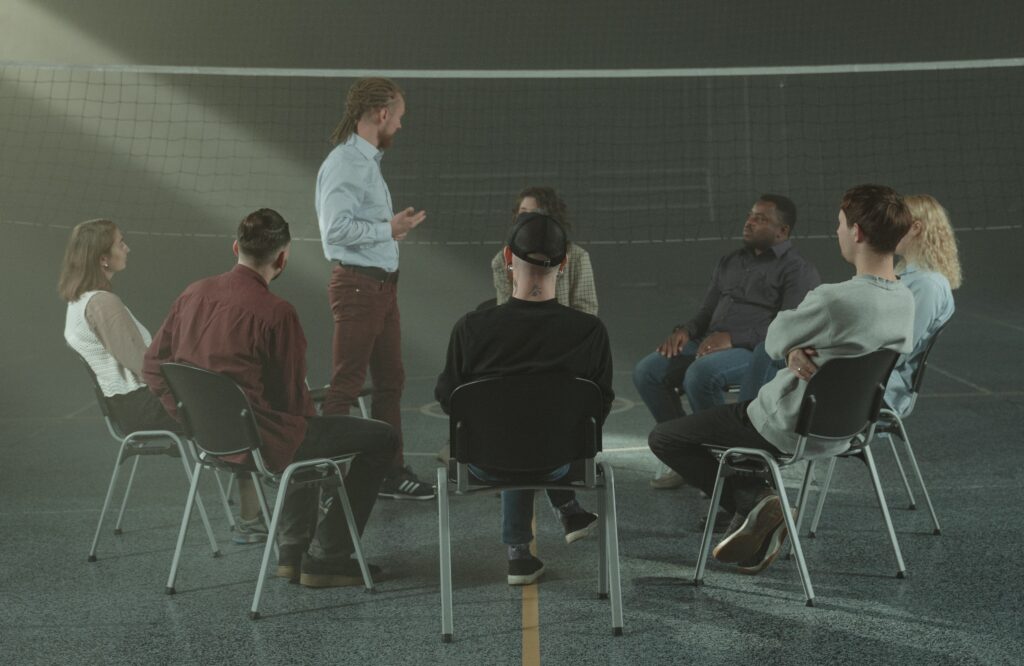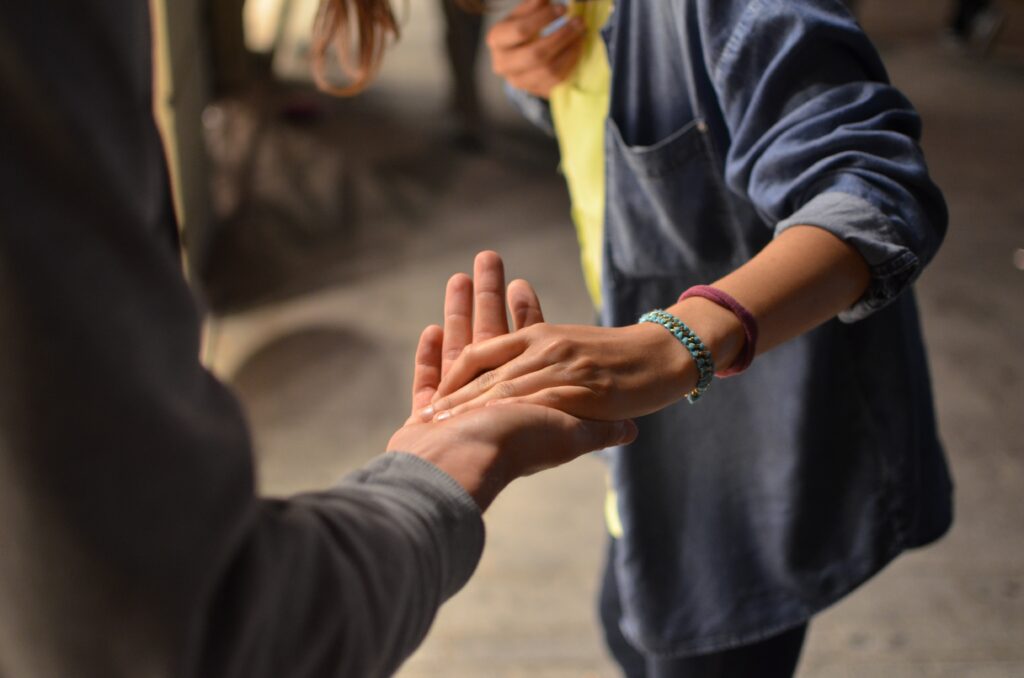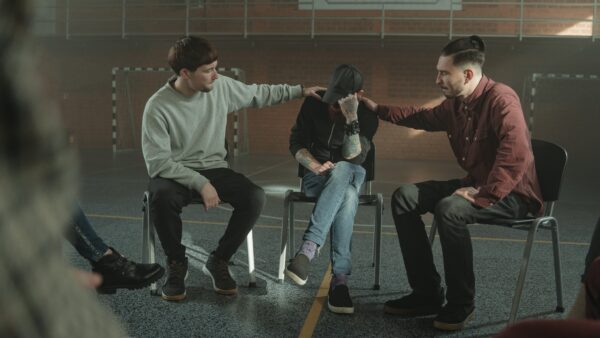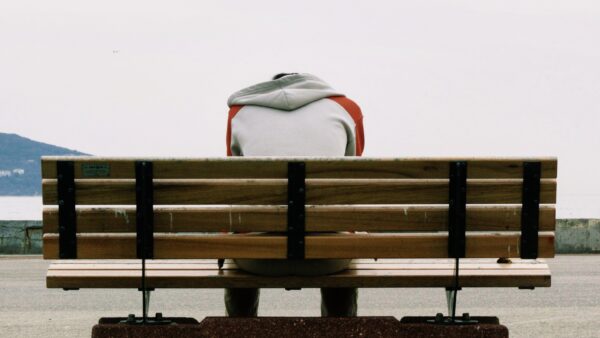7.1 Introduction
This module will look at restorative justice as a concept dealing with the broad range of conflicts that fall under the title of community-based conflict. It will firstly examine what restorative justice is and its justification regarding homelessness. Secondly, it will explore the real-world application of restorative justice in combatting conflicts that arise as a result of homelessness and how to heal the divisions that exist between communities and individuals.
7.2 Learning objectives
In this unit the learners will
- Learn the main concepts and principles behind restorative justice
- Explore how restorative justice can be applied to the criminal justice system
- Understand how restorative justice can play a role in healing familial relationships and conflicts
- Learn how restorative justice can be applied to homelessness
- Become familiar with examples of good practice for the provision of restorative justice in this area
7.3 What is Restorative Justice
In its essence, restorative justice is an approach to justice that aims to bring together the victim and perpetrator involved in a crime or dispute in order to restore the harm done. When applied to the criminal justice system, the victim and the offender will hold meetings, often supervised by police officers or social workers who will act as mediators in the discussion. The aim of these meetings is to discuss the motivations of the perpetrator, the harm caused to the victim and what can be done to aid the healing process going forward.
The restorative justice approach differs from the more common system of punitive justice. Punitive justice is a methodology that believes in punishment as a method to change individuals’ behavior through deterring crime in the first place, or by punishing criminals so severely that they do not offend again. While punitive justice must exist in one form or another to deter the most heinous of crimes, it does little to heal the fractures that are created by the crime or address its root causes. Restorative justice within the criminal justice system seeks to help the victim find closure over the events occurred, as well as involving the perpetrator in the healing process, rather than ostracizing them from the community they are a part of. It is important to note that the restorative justice methodology cannot be applied to every case, and it must be approached with the victim’s full cooperation and knowledge of the process. While the process aims to help the victim, the perpetrator, and the community, the needs of the victim must come first.
Outside of the criminal justice system, the application of restorative justice becomes more complex. This is because, in daily life relational conflicts, there often isn’t a clear division between a victim and an offender. However, even if conflicts don’t meet the threshold to be prosecuted in criminal courts or are simply not criminal in nature, they can still represent conflict. Thus, restorative justice can play a key role in these circumstances since the conflict can still be addressed and resolved, outside of the criminal justice system. Restorative justice theory dictates that all involved parties have an equal right to fairness, dignity, respect, and to be heard. Therefore, practices such as mediation and group healing are usually employed. These practices will be explored further in the unit.
The goal of applying restorative justice in these instances is to redistribute power by ensuring that all parties leave the session feeling as though their voices have been heard and their grievances addressed. Moreover, a clear plan will be drawn between the parties, establishing how to keep progressing further. These processes do not seek to attribute blame, but to explore motivations and causes of actions, while looking for solutions on how to move forward.
Nevertheless, as it happens with most theoretical approaches, restorative justice can also have its limitations. Restorative justice relies on being able to establish an open dialogue between the perpetrator and the victim, or the community, when they have caused harm. However, in the most damaging and toxic relationships, this dialogue cannot be established since it may expose the victim to further harm. This is especially evident in previously violent relationships, in which any attempt at re-engaging the victim with the perpetrator should be addressed on a case-by-case basis and handled very sensitively by experienced professionals, such as mediators and support figures. In situations such as these, it may be possible to explore opening a dialogue between the victim and their community in order to build social ties and give them a support network. Alternatively, in cases where the victim does not feel comfortable meeting with the perpetrator, the perpetrator can be introduced to the community, in order for them to understand the harm that they have caused, and work to prevent it from happening again. This will aid with the reintegration of the perpetrator back into the community, and hopefully prevent the likelihood of reoffending.
The link between homelessness and crime
Due to the very nature of homelessness and the difficulties resulting from it, many individuals get stuck in a cycle where their very existence becomes inherently illegal. This is exemplified by legislation restricting those facing unstable housing from residing in certain public locations, such as parks, shop fronts or subway stations. In some countries where these legislations are applied, it can result in the authorities physically removing homeless people from those specific locations where they were settled. Besides the clear dehumanization of homeless people resulting from such acts, the main consequence of these policies is the removal of individuals from their usual location and support networks, which prevents them from accessing organizations that may offer them support.
In these instances, simply existing as a homeless person becomes illegal, which creates a hostile environment for those living on the streets, as well as creating a negative relationship between these people and the communities where they live.
By criminalizing the existence of those experiencing homelessness, it only increases the likelihood that homeless people will turn to criminal activities to survive. By breaking down the relationship between communities and those who live on the edge of society, these policies end up causing more damage to individuals and to communities, rather than protecting them and establishing a peaceful and safe environment for all. There are examples of good practices that have sought to address the issues with criminalizing the homeless, and they are discussed in the section “Restorative Justice: Examples in Practice” below.

Restorative Justice: Mediation
Mediation is a practice that aims to establish a dialogue between groups or individuals that are in conflict, in order to achieve reconciliation. Its strengths lie in the parties cooperating in joint problem solving, while addressing the fears, concerns and needs of both parties, in order to find a way forward. This can often be referred to as a form of conflict resolution. It is difficult to narrow the definition of mediation further, since each application is defined by the participants, the conflict and the dialogue that needs to take place.
The process of initiating a restorative mediation can broadly be based around five simple questions that open the door to an in-depth and multi-faceted discussion. These are:
- What happened?
- Who has been impacted?
- What can we do to make it better?
- Who else has a stake in this conflict? (i.e., the wider community)
- Which were the motivations?
There are some debates that focus on where the line is drawn between restorative justice and mediation. Some views argue that restorative justice needs to have a clear victim and offender while mediation exists when the conflict is not as clear. As it has been previously discussed, we do not agree with this position, since mediation can be approached from a restorative justice standpoint, adopting the principles of an equal right to fairness, dignity, respect, and to be heard. For the practice to be considered restorative in our eyes, the mediation must not focus on attributing blame, but rather on acknowledging that past events occurred and establishing a course of action that will benefit all parties.
Another key aspect of a restorative mediation is to address the power imbalance that many damaged or broken relationships present. This is addressed since some relationships break apart due to one party exerting their power over another. This power can represent physical power, monetary power, or emotional abuse, among others. Restorative mediation aims to address these disparities and balance the power more evenly between the parties.
Monetary power can be used as an example: redistributing monetary power does not only mean equally distributing wealth between two groups, but rather addressing the influence and power that money may have on the parties. This means that the mediator and the affected parties must work on finding a mechanism that would prevent the powerful party from exerting their control in the future. This should also allow the weaker party to have some recourse that they could use to inform the powerful party when they are displaying damaging tendencies. At very least, the mediation process should communicate to the powerful that their actions are damaging and hurtful, with the less powerful party being able to communicate the impact this has on them.
Restorative Justice: Group Healing and the Circle Processes
“Group healing” and the “circle processes” address similar questions as those used in mediation (what happened, who has been impacted, what can we do to make amends, who else has a stake in the conflict, and what motivated the actions). However, while mediation focuses on arbitrating over conflicts between small groups, group healing and circle processes aim to allow for the formation of positive relationships outside of those immediately involved in the conflict.
These processes allow for a group of individuals that are connected by similar experiences or are part of similar communities to create positive bonds. They come together and share their experiences, honoring each other’s right to be heard. While speaking, each participant cannot be interrupted, since these are spaces of reflection and consideration, not for judgment or questions. The process itself is led by a professional who may guide the discussion and introduce topics. However, the discussions are mostly based on the expression of the participant’s experiences, rather than very specific topics. The right to not participate in the discussion and simply engage as an active listener is key to this process, since different individuals may need their time to feel comfortable opening up.

Restorative Justice: Examples in Practice
Community Safety Casework Team (CSCT) – Brighton and Hove City Council
Case outline:
- CSCT was called to a supported accommodation project after the manager of the project noticed that one resident had been acting in an abusive way to other residents, as well as engaging in antisocial behavior.
- This behavior had been gradually worsening for 6 months prior to the intervention from the CSCT.
- The resident then met a new group of people who began using the housing project as a space where to consume and sell drugs. This situation caused conflict with the other residents and staff.
The solution:
- The CSCT invited to all the residents and staff to a restorative circle. This gave each member of the project a space where to express their feelings freely. The purpose of this circle was to breakdown the existing social hierarchies and to give all participants equal prominence in the discussion.
- By using the circle, each member of the project was able to identify the problems that they perceived, and each person played a part in drawing up a plan to move forward.
- Instead of punishment for the individual, they took part of the process that sought to prevent further harm in their community.
The significance:
- This is an intervention method that can be applied to individuals that are struggling once they find temporary housing
- People moving from the streets to housing may have trouble adjusting to a world with concrete norms and regulations – this presents a system that can be proposed to housing projects or hostel staff to address issues before the individual is banned from returning to the center.
7.4 Further Reading and resources
- Healing Justice, Restorative Justice and the Circle Process, 2019.
- Liebmann & Wootton, Restorative Justice and Domestic Abuse/Violence. The Home Office Crime Reduction Unit for Wales, 2010.
- Liebmann, Restorative Justice: How It Works, 2007.
- Novac, S., Justice and Injustice: Homelessness, Crime, and the Criminal Justice System Centre for Urban & Community Studies, University of Toronto, 2006.
- Safe in The City, The successful use of restorative practice to repair harm in a supported accommodation project. Brighton & Hove City Council, 2018.
- Shenk and Zehr, Restorative Justice and Substance Abuse: The Path Ahead. SAGE journals, 2001.
- Weitekamp & Kerner, Restorative Justice: Theoretical foundations, 2011.






